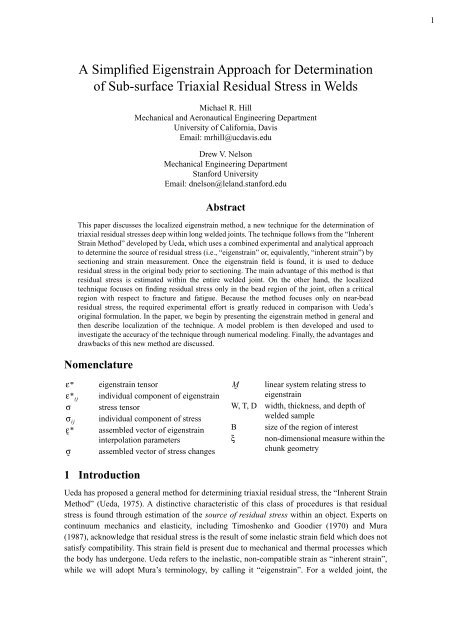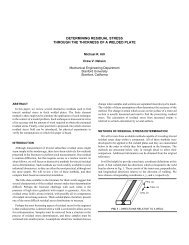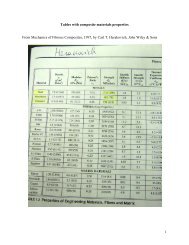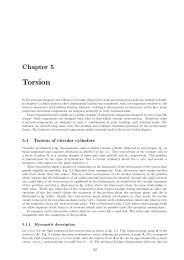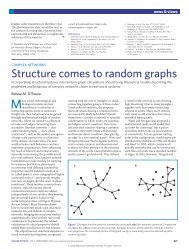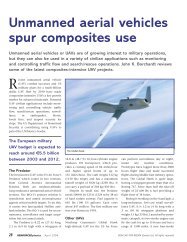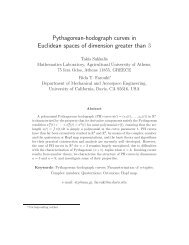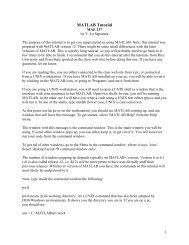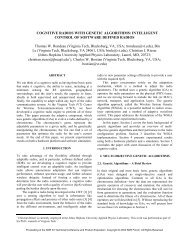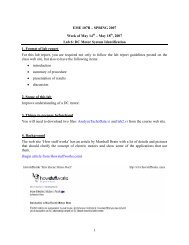A Simplified Eigenstrain Approach - Department of Mechanical and ...
A Simplified Eigenstrain Approach - Department of Mechanical and ...
A Simplified Eigenstrain Approach - Department of Mechanical and ...
You also want an ePaper? Increase the reach of your titles
YUMPU automatically turns print PDFs into web optimized ePapers that Google loves.
A <strong>Simplified</strong> <strong>Eigenstrain</strong> <strong>Approach</strong> for Determination<br />
<strong>of</strong> Sub-surface Triaxial Residual Stress in Welds<br />
Michael R. Hill<br />
<strong>Mechanical</strong> <strong>and</strong> Aeronautical Engineering <strong>Department</strong><br />
University <strong>of</strong> California, Davis<br />
Email: mrhill@ucdavis.edu<br />
Drew V. Nelson<br />
<strong>Mechanical</strong> Engineering <strong>Department</strong><br />
Stanford University<br />
Email: dnelson@lel<strong>and</strong>.stanford.edu<br />
Abstract<br />
This paper discusses the localized eigenstrain method, a new technique for the determination <strong>of</strong><br />
triaxial residual stresses deep within long welded joints. The technique follows from the “Inherent<br />
Strain Method” developed by Ueda, which uses a combined experimental <strong>and</strong> analytical approach<br />
to determine the source <strong>of</strong> residual stress (i.e., “eigenstrain” or, equivalently, “inherent strain”) by<br />
sectioning <strong>and</strong> strain measurement. Once the eigenstrain field is found, it is used to deduce<br />
residual stress in the original body prior to sectioning. The main advantage <strong>of</strong> this method is that<br />
residual stress is estimated within the entire welded joint. On the other h<strong>and</strong>, the localized<br />
technique focuses on finding residual stress only in the bead region <strong>of</strong> the joint, <strong>of</strong>ten a critical<br />
region with respect to fracture <strong>and</strong> fatigue. Because the method focuses only on near-bead<br />
residual stress, the required experimental effort is greatly reduced in comparison with Ueda’s<br />
original formulation. In the paper, we begin by presenting the eigenstrain method in general <strong>and</strong><br />
then describe localization <strong>of</strong> the technique. A model problem is then developed <strong>and</strong> used to<br />
investigate the accuracy <strong>of</strong> the technique through numerical modeling. Finally, the advantages <strong>and</strong><br />
drawbacks <strong>of</strong> this new method are discussed.<br />
Nomenclature<br />
ε*<br />
ε* ij<br />
σ<br />
σ ij<br />
ε ˜ *<br />
σ ˜<br />
eigenstrain tensor<br />
individual component <strong>of</strong> eigenstrain<br />
stress tensor<br />
individual component <strong>of</strong> stress<br />
assembled vector <strong>of</strong> eigenstrain<br />
interpolation parameters<br />
assembled vector <strong>of</strong> stress changes<br />
1 Introduction<br />
M linear system relating stress to<br />
˜<br />
eigenstrain<br />
W, T, D width, thickness, <strong>and</strong> depth <strong>of</strong><br />
welded sample<br />
B size <strong>of</strong> the region <strong>of</strong> interest<br />
ξ non-dimensional measure within the<br />
chunk geometry<br />
Ueda has proposed a general method for determining triaxial residual stress, the “Inherent Strain<br />
Method” (Ueda, 1975). A distinctive characteristic <strong>of</strong> this class <strong>of</strong> procedures is that residual<br />
stress is found through estimation <strong>of</strong> the source <strong>of</strong> residual stress within an object. Experts on<br />
continuum mechanics <strong>and</strong> elasticity, including Timoshenko <strong>and</strong> Goodier (1970) <strong>and</strong> Mura<br />
(1987), acknowledge that residual stress is the result <strong>of</strong> some inelastic strain field which does not<br />
satisfy compatibility. This strain field is present due to mechanical <strong>and</strong> thermal processes which<br />
the body has undergone. Ueda refers to the inelastic, non-compatible strain as “inherent strain”,<br />
while we will adopt Mura’s terminology, by calling it “eigenstrain”. For a welded joint, the<br />
1
2<br />
eigenstrain field is the combination <strong>of</strong> thermal, transformation, <strong>and</strong> plastic strains which are the<br />
net result <strong>of</strong> the welding process.<br />
Although residual stress is caused by eigenstrain, it is also a function <strong>of</strong> the geometry <strong>of</strong> the<br />
body in which it is imposed. For example, imagine a long welded plate. If a sample is removed<br />
from the plate that is short along the weld-length, stress will be released in removing the sample.<br />
The stress has changed, but the eigenstrain within the removed sample remains the same,<br />
assuming that the cutting process results only in elastic deformation <strong>of</strong> the sample. The<br />
eigenstrain method is a form <strong>of</strong> destructive sectioning, as strain released during geometry<br />
changes is used to deduce the underlying eigenstrain distribution. The eigenstrain distribution is<br />
complicated, however, since it represents the spatial variation <strong>of</strong> a tensor quantity. If the<br />
eigenstrain can be found, it can then be used to estimate residual stress in the original sample,<br />
prior to cutting, <strong>and</strong> also in the structure from which the sample was removed.<br />
Application <strong>of</strong> the eigenstrain approach to residual stress in continuously welded joints was<br />
presented by Ueda, et al. (1985) <strong>and</strong> further studied in a recent paper (Hill <strong>and</strong> Nelson, 1995).<br />
Consider a long, continuously welded plate with directions which correspond to the weld bead as<br />
shown in Figure 1. These consist <strong>of</strong> the transverse, perpendicular, <strong>and</strong> longitudinal directions<br />
relative to the direction <strong>of</strong> welding. We have chosen corresponding coordinates x,<br />
y,<br />
<strong>and</strong> z,<br />
respectively. The assumption <strong>of</strong> continuous welding allows consideration <strong>of</strong> an eigenstrain field<br />
that is dependent on the transverse <strong>and</strong> perpendicular coordinates, while independent <strong>of</strong> the<br />
longitudinal coordinate. The basis for this assumption is that each plane in the weld<br />
cross-section, like the two shaded in Figure 2, is thought to experience the same thermal <strong>and</strong><br />
mechanical processes during a continuous weld pass. This assumption holds neither in the<br />
thermal nor the mechanical sense near the ends <strong>of</strong> the joint, but the assumption may be<br />
reasonable in the remainder <strong>of</strong> the joint, as indicated by experimental evidence presented by Hill<br />
<strong>and</strong> Nelson (1996).<br />
Long. (z)<br />
Perp. (y)<br />
Trans. (x)<br />
Figure 1 – Directions relative to a weld.<br />
Long. (z)<br />
Perp. (y)<br />
Trans. (x)<br />
Figure 2 – Two planes which have the same<br />
eigenstrain distribution.<br />
An illustration <strong>of</strong> Ueda’s technique is shown in Figure 3. A sample <strong>of</strong> welded plate, obtained<br />
from the structure <strong>of</strong> interest, is instrumented with an array <strong>of</strong> strain gages on one <strong>of</strong> its faces<br />
normal to the z-axis<br />
(shaded in the figure). Two strain-relaxation measurements are then<br />
performed, one from block to thin slice <strong>and</strong> the other from slice to small pieces (dice), each<br />
containing a strain gage. Since the slice is in plane stress, slice-to-dice data allow determination<br />
<strong>of</strong> the x-y distribution <strong>of</strong> the eigenstrain components in the transverse-perpendicular plane ( ε* xx ,<br />
ε* yy , <strong>and</strong> ε* xy ). Using these results with the block-to-slice relaxation data allows determination<br />
<strong>of</strong> the eigenstrain component associated with the longitudinal direction ( ε* zz ). The two<br />
additional components <strong>of</strong> eigenstrain ( ε* yz <strong>and</strong> ε* zx<br />
) are assumed to be zero because they<br />
would cause asymmetrical stresses to arise in the welded joint which is contrary to empirical<br />
observation (Ueda, et al., 1985). Ueda’s method, then, allows determination <strong>of</strong> the x-y
distribution <strong>of</strong> the entire eigenstrain tensor <strong>and</strong> assumes the distribution is independent <strong>of</strong> z.<br />
Since the total eigenstrain field is known, residual stress can be found in the original specimen<br />
geometry, prior to sectioning, or in the structural geometry prior to specimen removal by<br />
imposing the eigenstrain field in an elastic finite element model (Hill, 1995).<br />
The determination <strong>of</strong> eigenstrain components from measured changes in strain involves<br />
solution <strong>of</strong> a linear system found by repetitive finite element method calculations, as described<br />
by Hill <strong>and</strong> Nelson (1995). For a given sectioning operation, the linear system relates measured<br />
changes in stress at specific points on the object to parameters <strong>of</strong> an eigenstrain interpolation.<br />
This linear system is very much like the stiffness matrix <strong>of</strong> finite element analysis (FEA) which<br />
relates internal forces to internal displacements. Just as in FEA, the formulation <strong>of</strong> the linear<br />
system depends on the type <strong>of</strong> interpolation chosen (i.e., the "shape functions") <strong>and</strong> the<br />
organization <strong>of</strong> the interpolation parameters (i.e., "assembly"). In all <strong>of</strong> the work reported here,<br />
we choose to approximate the distribution <strong>of</strong> each component <strong>of</strong> eigenstrain using linear<br />
interpolation in spatial coordinates. Once the interpolation scheme <strong>and</strong> an arbitrary system<br />
organization (row <strong>and</strong> column order) are adopted, a linear system can be formed relating stress to<br />
eigenstrain,<br />
σ = M ⋅ ε* . [1]<br />
˜ ˜ ˜<br />
Given measured stress components, σ , the eigenstrain parameters, ε* (akin to nodal values <strong>of</strong><br />
˜<br />
˜<br />
displacement in FEA) can be found by inversion <strong>of</strong> Equation [1].<br />
Long. (z)<br />
Figure 3 – Pictorial representation <strong>of</strong> the<br />
slice-<strong>and</strong>-dice method proposed by Ueda (1985).<br />
Perp. (y)<br />
Trans. (x)<br />
Figure 4 – Region in a welded block where<br />
residual stress is determined by the localized<br />
eigenstrain method.<br />
A major drawback <strong>of</strong> Ueda’s method is that a daunting number <strong>of</strong> strain-relaxation<br />
measurements must be conducted using sectioning <strong>and</strong> strain gage instrumentation. Recently, the<br />
authors have developed a localization <strong>of</strong> Ueda’s approach which allows stress to be determined<br />
only in close proximity to the weld bead (Hill, 1996b). Limitation to this region is reasonable<br />
from the st<strong>and</strong>point <strong>of</strong> failure assessment, as weld defects <strong>and</strong> large residual stresses are likely to<br />
exist together only in or very near the weld bead. Since the transverse extent <strong>of</strong> the weld bead is<br />
<strong>of</strong>ten on the order <strong>of</strong> the thickness <strong>of</strong> the welded plate, the localized technique was developed to<br />
find residual stress within the hexahedral region shaded in Figure 4.<br />
2 Description <strong>of</strong> the Localized <strong>Eigenstrain</strong> Method<br />
Localization <strong>of</strong> the eigenstrain method for a continuous weld is based on a modification <strong>of</strong> the<br />
sectioning technique proposed by Ueda <strong>and</strong> is shown schematically in Figure 5. This process<br />
differs from that shown in Figure 3 in two ways. First, only the bead region on the face <strong>of</strong> the<br />
welded sample, shown shaded in the figure, is instrumented with strain gages. Secondly, the<br />
sectioning process includes an intermediate “chunk” geometry between slice <strong>and</strong> dice, created by<br />
3
4<br />
removing the region <strong>of</strong> interest from the slice. This modified sectioning process allows for<br />
separation <strong>of</strong> the eigenstrain field into two portions, one lying inside <strong>and</strong> one outside <strong>of</strong> the<br />
region <strong>of</strong> interest.<br />
Figure 5 – Pictorial representation <strong>of</strong> the localized<br />
eigenstrain technique for continuous welds.<br />
The localized eigenstrain method is most easily described with a specific geometry,<br />
sectioning plan, <strong>and</strong> strain measurement scheme in mind. Assume that a block <strong>of</strong> material has<br />
been removed from a welded joint <strong>and</strong> has dimensions shown in Figure 6(a). A region <strong>of</strong> interest<br />
in the xy-plane<br />
<strong>of</strong> this block is identified, shown shaded in the figure. The free surface <strong>of</strong> this<br />
region is instrumented as shown in Figure 7. Following instrumentation, the block is sectioned as<br />
shown schematically in Figure 5 with dimensions <strong>of</strong> the slice <strong>and</strong> chunk shown in Figure 6(b)<br />
<strong>and</strong> (c). Strain changes are measured that accompany removal <strong>of</strong> the slice from the block,<br />
removal <strong>of</strong> the chunk from the slice, <strong>and</strong> finally cutting the slice into dice. Assuming that the dice<br />
are small enough relative to the spatial gradients <strong>of</strong> eigenstrain, the dice will be stress-free. Using<br />
relaxation data with elastic stress-strain relations for plane stress, residual stress can then be<br />
computed at the free-surface measurement sites on the block, slice, <strong>and</strong> chunk geometries. The<br />
localized eigenstrain method then uses these reduced stress data to estimate the eigenstrain<br />
distribution which, in turn, allows stress to be computed at any point in the region <strong>of</strong> interest.<br />
2.1 Division <strong>of</strong> eigenstrain into<br />
ε*<br />
A <strong>and</strong> ε*<br />
B<br />
Figure 6 – (a) Block <strong>of</strong> material removed from a<br />
welded joint, (b) slice removed from the block, <strong>and</strong><br />
(c) chunk removed from the slice. The chunk would<br />
further be sectioned into dice.<br />
One <strong>of</strong> the crucial steps in assuring success <strong>of</strong> the localized eigenstrain method is separation<br />
<strong>of</strong> the eigenstrain into two parts. The first part, ε* B , is found from stress in the chunk, <strong>and</strong> the<br />
second part, ε* A , from stress in the slice. This second part <strong>of</strong> the eigenstrain is further divided<br />
into two distinct parts. The first is eigenstrain which lies within the region <strong>of</strong> the chunk, but does<br />
not cause stress once the chunk is cut free from the slice. The second part <strong>of</strong> ε* A<br />
is an<br />
approximate representation for eigenstrain which lies outside <strong>of</strong> the chunk region. To correctly<br />
account for this division, the x-interpolation<br />
for each portion <strong>of</strong> the eigenstrain has been carefully<br />
developed (Hill, 1996b). The y-interpolation,<br />
on the other h<strong>and</strong>, is a simple linear interpolation<br />
with seven equally spaced nodes.<br />
T<br />
z<br />
W = 203mm<br />
T = 38mm<br />
D = 127mm<br />
B = 0.8T<br />
y<br />
x<br />
B<br />
W<br />
T<br />
3B<br />
B<br />
D/20<br />
D<br />
D/20<br />
(a)<br />
(b)<br />
(c)
y = 0<br />
-1/6 T<br />
-1/3 T<br />
-1/2 T<br />
-2/3 T<br />
-5/6 T<br />
-T<br />
x o–<br />
1/3 B<br />
x = xo<br />
Region <strong>of</strong><br />
Interest<br />
x o+<br />
1/3 B<br />
= Strain Measurement Location<br />
Figure 7 – Measurement locations within the<br />
region <strong>of</strong> interest where three-element strain gage<br />
rosettes would be placed.<br />
2.2 Scheme for interpolation <strong>of</strong><br />
ε* B<br />
ε*<br />
B<br />
Functions used to interpolate in the x-direction<br />
are shown in Figure 8. These functions<br />
are the result <strong>of</strong> two important considerations. First, eigenstrain distributions which would cause<br />
stress-free deformation in the chunk are explicitly excluded by proper choice <strong>of</strong> the interpolation<br />
scheme. For each particular component <strong>of</strong> eigenstrain, this amounts to assuring that the<br />
compatibility relations <strong>of</strong> elasticity cannot be satisfied by any combination <strong>of</strong> the interpolation<br />
functions. Second, spacing between interpolation nodes for a particular component is constant. It<br />
was found that even spacing produces a linear system for eigenstrain determination which is as<br />
well conditioned as possible, <strong>and</strong> therefore produces superior estimates <strong>of</strong> the eigenstrain<br />
parameters. The functions shown in Figure 8 satisfy these two criteria.<br />
2.3 Scheme for interpolation <strong>of</strong><br />
ε*<br />
A<br />
ξ=−0.5 ξ=0<br />
ξ=0.5<br />
ξ=−0.25 ξ=0.25<br />
ξ=−1/6 ξ=1/6<br />
(a) Interpolation <strong>of</strong> ε* xx<br />
(b) Interpolation <strong>of</strong> ε* yy<br />
(c) Interpolation <strong>of</strong> ε* xy<br />
Figure 8 – Interpolation functions used to distribute<br />
ε* B in the chunk. ξ = ( x – xo) ⁄ B , where xo<br />
is the<br />
center <strong>of</strong> the chunk <strong>and</strong> B is the width <strong>of</strong> the region<br />
<strong>of</strong> interest. Measurements taken at ξ = -1/3, 0, 1/3.<br />
Again, there are two parts <strong>of</strong> the eigenstrain distribution which cause stresses in the slice <strong>and</strong><br />
cannot be predicted by stresses in the chunk. The first part is the eigenstrain which causes stress<br />
when present in the chunk region <strong>of</strong> the slice geometry, but causes no stress once the chunk is cut<br />
free. The interpolation <strong>of</strong> this portion <strong>of</strong> ε* A varies for each component <strong>of</strong> eigenstrain, as shown<br />
in Figure 9(a) <strong>and</strong> (b). For ε* xx , there are no stress-free modes <strong>of</strong> eigenstrain distribution which<br />
are not also stress-free in the slice. The second part <strong>of</strong> the eigenstrain to be determined by stress<br />
in the slice is the eigenstrain which lies outside <strong>of</strong> the chunk region, . It was found, by trial<br />
ξ=−5/6 ξ=−0.5 ξ=0.5 ξ=5/6<br />
ξ=−5/6 ξ=−0.5 ξ=0.5 ξ=5/6<br />
ξ=−5/6 ξ=−0.5 ξ=0<br />
ξ=0.5 ξ=5/6<br />
ε* A<br />
(a) Interpolation <strong>of</strong> ε* yy<br />
(b) Interpolation <strong>of</strong> ε* xy<br />
(c) Sawtooth functions common<br />
to all components.<br />
Figure 9 – Interpolation functions used to distribute eigenstrain determined from<br />
stress in the slice, ε* A . ξ = ( x – xo) ⁄ B , where xo is the center <strong>of</strong> the chunk.<br />
5
6<br />
<strong>and</strong> error, that the specific functions used to interpolate this part <strong>of</strong> the eigenstrain does not alter<br />
the results <strong>of</strong> the stress approximation within the region <strong>of</strong> interest.<br />
Therefore, the simple<br />
sawtooth functions shown in Figure 9(c) are used to interpolate each component <strong>of</strong> eigenstrain<br />
outside the region <strong>of</strong> interest.<br />
2.4 Interpolation for longitudinal eigenstrain, ε* zz<br />
In estimating the longitudinal eigenstrain component, there is no distinction between the<br />
chunk <strong>and</strong> the slice, except in a discontinuity in interpolation across the boundary <strong>of</strong> the region <strong>of</strong><br />
interest. That is, the solution procedure for finding a parameterized distribution <strong>of</strong> ε* zz is the<br />
same as in the non-localized method, except for the interpolation functions used. The proper<br />
interpolation for ε* zz is the same as that used for ε* xx as shown in Figure 8(a) <strong>and</strong> Figure 9(c).<br />
To find the longitudinal eigenstrain, the distribution <strong>of</strong> the planar components <strong>of</strong> eigenstrain<br />
is estimated as described above, then these are imposed in a finite element model <strong>of</strong> the block to<br />
find the stresses that they cause on its free-surface. These stresses are subtracted from the<br />
experimental estimates <strong>of</strong> residual stress on the block free-surface, <strong>and</strong> the differences used to<br />
determine the parameters in the interpolation.<br />
3 Numerical Simulation <strong>of</strong> the Method<br />
The accuracy <strong>of</strong> the method described above will depend greatly on the residual stress<br />
distribution being measured. Our goal in this section is to assess the accuracy with respect to one<br />
residual stress system in particular through numerical simulation <strong>of</strong> the technique.<br />
The goal <strong>of</strong> the simulation is to find residual stress within the sample <strong>of</strong> welded plate<br />
depicted in Figure 6(a). Residual stress is produced in a finite element model <strong>of</strong> each specimen<br />
shown in Figure 6 by introduction <strong>of</strong> an eigenstrain field. The resulting residual stress state is<br />
fully three-dimensional, <strong>and</strong> exists everywhere within the body. The specific eigenstrain field<br />
used is given in detail in an earlier paper (Hill <strong>and</strong> Nelson, 1995). This field was developed to<br />
produce a complicated residual stress state that resembles the character <strong>of</strong> thick-weld residual<br />
stress; however, this field should not be construed to be the residual stress state present in any<br />
real weld. Its sole purpose is to provide a basis by which to compare techniques for residual<br />
stress determination. Residual stresses on specific contours through the weld are shown in<br />
Figures 10 <strong>and</strong> 11. These stresses are the result <strong>of</strong> a direct finite element computation <strong>and</strong> are<br />
identified as “exact,” meaning that a perfect measuring technique would obtain the same results.<br />
The linear systems are formed for determination <strong>of</strong> ε* B , ε* A , <strong>and</strong> ε* zz using the<br />
interpolation schemes described above. These systems are then used with stress on the<br />
free-surfaces <strong>of</strong> the chunk, slice, <strong>and</strong> block computed by FEA. That is, the FEA results on the<br />
free-surface are used as input to the localized eigenstrain method. Parameters determined from<br />
solution <strong>of</strong> these systems are then used to interpolate the total eigenstrain on a model <strong>of</strong> the block<br />
geometry, <strong>and</strong> residual stress estimates within the block are obtained. Stress estimates at the weld<br />
midlength are compared to FEA results in Figure 12. Good agreement between the two sets <strong>of</strong><br />
results is obtained. The largest errors present are in near the surface <strong>of</strong> the joint.<br />
4 Discussion<br />
ε* zz<br />
Numerical simulation indicates that the localized eigenstrain method can be used to estimate<br />
residual stresses at the midplane <strong>of</strong> the block to a good degree <strong>of</strong> accuracy. The maximum<br />
difference between estimated <strong>and</strong> exact stress is smaller than that obtained using the<br />
σ zz
Figure 10 – Residual stresses at the center <strong>of</strong> the<br />
sample, through the thickness <strong>of</strong> the plate.<br />
Stress (MPa)<br />
Stress (MPa)<br />
Long. (z)<br />
150<br />
100<br />
50<br />
Stress (MPa)<br />
0<br />
-50<br />
-100<br />
250<br />
200<br />
150<br />
100<br />
50<br />
0<br />
-50<br />
-100<br />
-150<br />
Perp. (y)<br />
200<br />
150<br />
100<br />
50<br />
0<br />
-50<br />
-100<br />
-150<br />
-38<br />
Trans. (x)<br />
-28.5<br />
FEA: σ xx<br />
FEA: σ yy<br />
FEA: σ zz<br />
FEA: σ xy<br />
Exact: σ xx<br />
Exact: σ yy<br />
Exact: σ zz<br />
-19 -9.5<br />
y (mm)<br />
-35 -30 -25 -20 -15 -10 -5 0<br />
FEA: σ xx<br />
FEA: σ yy<br />
FEA: σ zz<br />
FEA: σ xy<br />
y (mm)<br />
0<br />
Long. (z)<br />
Perp. (y)<br />
Trans. (x)<br />
-50<br />
0 50.75 101.5<br />
Figure 11 – Residual stress at the center <strong>of</strong> the<br />
weld length, across the top surface.<br />
Figure 12 – (a), (b), (c): Stress at the midplane <strong>of</strong> the block induced by the model eigenstrain<br />
function as computed by FEA, compared to those estimated by the localized eigenstrain<br />
method. Each plot is for a different x-location, as indicated at the bottom-right.<br />
(d) Error in mid-plane stress estimates for the localized eigenstrain technique <strong>and</strong> the "regular" technique<br />
proposed by Ueda (adapted from (Hill <strong>and</strong> Nelson, 1995)) on the line x = 96.5mm.<br />
Stress (MPa)<br />
(a) (b)<br />
-35 -30 -25 -20 -15 -10 -5 0<br />
y (mm)<br />
(c)<br />
Loc. ε*: σ xx<br />
Loc. ε*: σ yy<br />
Loc. ε*: σ zz<br />
Loc. ε*: σ xy<br />
Midplane, <strong>and</strong> x=86.4<br />
Loc. ε*: σ xx<br />
Loc. ε*: σ yy<br />
Loc. ε*: σ zz<br />
Loc. ε*: σ xy<br />
Midplane, <strong>and</strong> x=107<br />
Stress (MPa)<br />
Stress (MPa)<br />
250<br />
200<br />
150<br />
100<br />
50<br />
0<br />
-50<br />
-100<br />
-150<br />
30<br />
20<br />
10<br />
0<br />
-10<br />
-20<br />
-30<br />
-40<br />
200<br />
150<br />
100<br />
50<br />
0<br />
FEA: σ xx<br />
FEA: σ yy<br />
FEA: σ zz<br />
FEA: σ xy<br />
Loc. ε*: Error σ xx<br />
Loc. ε*: Error σ yy<br />
Loc. ε*: Error σ zz<br />
x (mm)<br />
(d)<br />
Exact: σ xx<br />
Exact: σ zz<br />
152.2 203<br />
-35 -30 -25 -20 -15 -10 -5 0<br />
y (mm)<br />
Reg. ε*: Error σ xx<br />
Reg. ε*: Error σ yy<br />
Reg. ε*: Error σ zz<br />
-35 -30 -25 -20 -15 -10 -5 0<br />
y (mm)<br />
Loc. ε*: σ xx<br />
Loc. ε*: σ yy<br />
Loc. ε*: σ zz<br />
Loc. ε*: σ xy<br />
Midplane, <strong>and</strong> x=96.5<br />
Midplane, <strong>and</strong> x=96.5<br />
7
8<br />
“non-localized” eigenstrain method, as shown in Figure 12(d). The improved accuracy is the<br />
result <strong>of</strong> the improved shape functions used to interpolate the eigenstrain. In developing these<br />
functions, an effort was made to minimize the number <strong>of</strong> eigenstrain components which are lost<br />
to modes <strong>of</strong> stress-free deformation during the inversion <strong>of</strong> Equation [1]. Overall, the difference<br />
between estimated <strong>and</strong> exact stress for either method is fairly small in relation to the levels <strong>of</strong><br />
stress present in the block, as shown in Figure 12(a)–(c).<br />
The development <strong>of</strong> the localized eigenstrain technique adds to the ability <strong>of</strong> the technique<br />
developed by Ueda. The localized method has the advantages <strong>of</strong> Ueda’s method, while being<br />
easier to implement for determination <strong>of</strong> stresses near a weld bead. The experimental effort<br />
required for the two techniques differs greatly. Implementation <strong>of</strong> Ueda’s technique, as described<br />
by Hill <strong>and</strong> Nelson (1995), would require 140 three-element strain gage rosettes. The localized<br />
technique, on the other h<strong>and</strong>, would require only 21. This is a large reduction in effort, which<br />
makes use <strong>of</strong> the eigenstrain technique much more practical. Not only is the experimental effort<br />
reduced, but the computational burden as well since one finite element solution must be obtained<br />
for each eigenstrain parameter in the interpolation system. As described by Hill <strong>and</strong> Nelson<br />
(1995), Ueda’s technique had 500 such parameters while the method presented here has only<br />
147. For these reasons, the localized eigenstrain method adds ease <strong>of</strong> execution to the previously<br />
existing method developed by Ueda.<br />
5 Conclusion<br />
A localized version <strong>of</strong> Ueda’s inherent strain (or, eigenstrain) method has been developed to<br />
enable determination <strong>of</strong> weld residual stresses by sectioning with a considerable reduction in<br />
experimental <strong>and</strong> computational efforts required. The new method retains the ability <strong>of</strong> the<br />
eigenstrain approach to estimate triaxial residual stress through the thickness <strong>of</strong> the welded joint<br />
but obtains results only in the bead region.<br />
6 References<br />
Hill, M. R. <strong>and</strong> D. V. Nelson (1995). “The inherent strain method for residual stress determination<br />
<strong>and</strong> its application to a long welded joint.” PVP v. 318. New York, NY, ASME. pp. 343-352.<br />
Hill, M. R. <strong>and</strong> D. V. Nelson (1996). “Determining residual stress through the thickness <strong>of</strong> a<br />
welded plate.” PVP v. 327. New York, NY, ASME. pp. 29-36.<br />
Hill, M. R. (1996b). Determination <strong>of</strong> Residual Stress Based on the Estimation <strong>of</strong> <strong>Eigenstrain</strong>,<br />
PhD Dissertation, Stanford University.<br />
Mura, T. (1987). Micromechanics <strong>of</strong> Defects in Solids. Dordrecht, Netherl<strong>and</strong>s, M. Nijh<strong>of</strong>f.<br />
Timoshenko, S.P. <strong>and</strong> J.N. Goodier, 1970, Theory <strong>of</strong> Elasticity. New York, McGraw-Hill.<br />
Ueda, Y., K. Fukuda, et al. (1975). “A new measuring method <strong>of</strong> residual stresses with the aid <strong>of</strong><br />
finite element method <strong>and</strong> reliability <strong>of</strong> estimated values.” Transactions <strong>of</strong> the JWRI 4(2): pp.<br />
123-131.<br />
Ueda, Y., Y. C. Kim, et al. (1985). “Measuring Theory <strong>of</strong> Three-Dimensional Residual Stresses<br />
Using a Thinly Sliced Plate Perpendicular to Welded Line.” Transactions <strong>of</strong> the JWRI 14(2):<br />
pp. 151-157.


